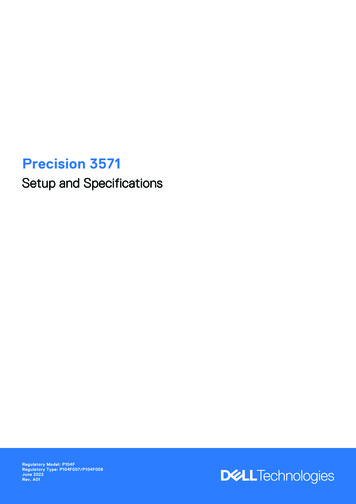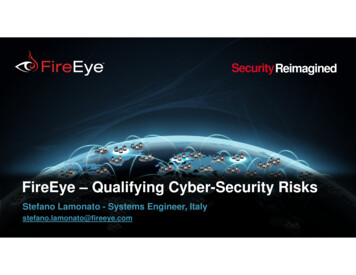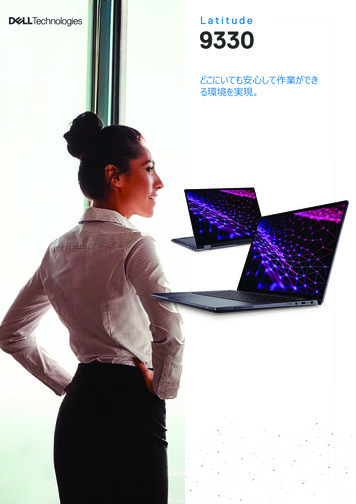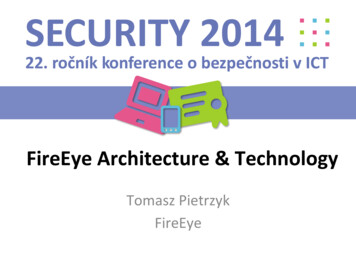
Transcription
2015Dell SecurityAnnual Threat Report1
Table of ContentsIntroduction3Threat Findings for 20144Key Industry Observations of 201413Final Takeaways14Resources152
IntroductionIn today's connected world, security is an ongoing process,not a point-in-time solution.Organizations are spending more than ever on IT security, both to comply with internal and regulatoryrequirements and to protect their data from cyber threats. Yet each year, high-profile data breachescontinue to fill the headlines, sabotaging the reputations, relationships, and revenue of the businessesthat are victimized.It’s clear that cyber-crimes are alive and well on the global stage and will continue to be pervasive as longas organizations delay taking the necessary defense measures to stop threats from slipping through thecracks. In the 2015 Dell Security Annual Threat Report, we’ll present the most common attacks that wereobserved by the Dell SonicWALL Threat Research Team in 2014 and the ways we expect emergentthreats to affect businesses of all sizes throughout 2015. Our goal is not to frighten, but to inform andprovide organizations of all sizes with practical advice that will help them adjust their practices to moreeffectively prepare for and prevent attacks, even from threat sources that have yet to emerge.1.7 trillion IPS attacks blockedIn 2014, we collected 37 millionunique malware samples, almostdouble the 19.5 million from 2013.billion malware attacks blockedPut another way, every day in2014, attackers launched twice as many unique attacks on your systemswith malicious code. We saw 88 trillion hits for application traffic and45 billion hits for post-infection malware activity.4.2Key findings include: a surge in point-of-sale (POS) malware and attacks; a dramatic increase in Secure Sockets Layer (SSL) and Transport Layer Security (TLS) encryptedInternet traffic; and twice the attacks on supervisory control and data acquisition (SCADA) systems.The data was gathered by the Dell Global Response Intelligence Defense (GRID) Network, whichsources information from a number of devices and resources including: more than one million security sensors in more than 200 countries; activity from honeypots in Dell’s threat centers; malware/IP reputation data from tens of thousands of firewalls and email security devicesaround the globe; shared threat intelligence from more than 50 industry collaboration groups and researchorganizations; intelligence from freelance security researchers; and spam alerts from millions of computer users protected by Dell SonicWALL email securitydevices.3
Threat Findings for 2014One of the best ways to predict and prepare for emergentthreats is to analyze information about recent breaches. Dell’spredictions and security recommendations for 2015 revolvearound eight key findings:1A surge took place in POS malware variants and attacks targeting payment cardinfrastructures.The retail industry was shaken to its core in 2014 after a staggering number of major retail brandsexperienced highly publicized POS breaches. Home Depot, Target, Michaels, and Staples all becametargets of credit card data theft, with each breach exposing millions of consumers to potentialfraudulent purchases and/or identity theft. Target’s was considered the largest breach in the history ofU.S. retail, with 40 million card numbers stolen, until Home Depot’s breach compromised 56 millioncard numbers just a few months later.1,2 In the case of Home Depot and Michaels, the attacks tookplace over several months before they were detected.3Dell saw a rise in POS attacks attempted among Dell SonicWALL customers as well.In 2014, we developed and deployed more than 3X more new POS malware countermeasuresthan the previous year. Dell SonicWALL created 13 POS malware signatures in 2014, compared with three in 2013 – a333% increase in the number of new POS malware countermeasures developed and deployed. The majority of these POS hits targeted the U.S. retail industry. We saw POS malware tactics evolve in 2014, with new trends including memory scraping andthe use of encryption to avoid detection from firewalls.It begs the question: In a modern retail environment, where compliance to payment card industry(PCI) standards is mandatory, how does this happen? The most common causes include inadequatelytrained employees, lax firewall policies between network segments and in the B2B portal, and relianceon a single layer of defense or an array of poorly integrated products. Or in Target’s case, the attackcame indirectly through the company’s HVAC vendor, who likely received deeper user permissionsthan needed.14
Timeline of High Profile Retail BreachesTo subvert the multitude of compliance regulations and corporate policies in place, cyber criminalsare taking a multi-vector approach, exploiting a few key areas of concern that, if unaddressed, will leadto a continued surge in POS attacks over the coming months. Companies should consider thefollowing approaches: Traditional POS applications run on terminals connected to a central computer. Often, theoperating system (OS) of this central computer is not kept updated, which can make the POSsystem as a whole highly vulnerable. It’s important to keep this OS patched and all softwareupdated. Keep the POS system isolated from the rest of the network. Make sure POS systems can onlycommunicate with valid IP addresses, so attackers cannot siphon data off to their own servers. Restrict activity on terminals to only POS-related activities (no web browsing). Install firewalls between network segments and in the B2B portal. Do not rely on a single layer of defense or an array of products that are not properly integrated. Make security training a significant part of employee onboarding and ongoing communications.Dell’s recent Global Technology Adoption Index (GTAI) showed that employee security trainingis lacking in all industries, including retail. An astounding 56% of companies admit that not all oftheir employees are aware of security rules.4 Think about how to truly protect your data from attackers, not just how to meet complianceregulations. Retail is the only industry in which companies are devoting more financialresources to compliance-related security concerns than to hacker-related concerns.4 Thiscould explain why companies like Target (and its HVAC vendor, through whom the attack wasdeployed) sometimes have compliant technology in place, but do not have adequate processesin place for addressing threats. Adopt a security policy that trusts nothing (network, resources, etc.) and nobody (vendors,franchisees, internal personnel, etc.), and then add explicit exceptions. Separate groups and zones to keep attackers who have gained network access frompenetrating further.5
Inspect all traffic at every node on every segment, inbound and outbound, and automaticallyinvestigate anomalies. Enforce email security to block malware in spam and phishing attacks. Unify multiple technologies into a platform that protects against threats. Don’t sacrifice security for performance.2More companies were exposed to attackers hiding in plain sight as a result ofSSL/TLS encrypted traffic.For many years, financial institutions and other companies that deal with sensitive information haveopted for the secure HTTPS protocol that encrypts information being shared. Now other sites likeGoogle, Facebook, and Twitter are adopting this practice as well in response to a growing demand foruser privacy and security.Dell saw a 109% increase in the volume of HTTPS web connections from the start of 2014 to thestart of 2015. Dell saw an increase in the volume of HTTPS web connections from 182 billion in January 2014to 382 billion in January 2015, and this number continues to grow. As of March 2015, thenumber was 437 billion.Although there are many benefits to using more Internet encryption, we are seeing a less positivetrend emerge as hackers exploit this encryption as a way of “hiding” malware from corporate firewalls.In early 2014, hackers successfully distributed malware to about 27,000 Europeans per hour over thecourse of four days, simply by infecting a group of banner advertisements on Yahoo’s news site. SinceYahoo’s site was encrypted, this malware was able to tunnel through users’ firewalls unseen.5HTTPS Hits as Percentage of Total Hits66%64%62%60%58%% of HTTPS -1450%6
Web Browsing Hits: HTTPs vs. 0000000000While managing against this threat is complicated, organizations can provide threat protection forencrypted traffic by implementing SSL inspection.3Attacks doubled on SCADA systems.Industrial operations often use SCADA systems to control remote equipment and collect data on thatequipment’s performance. Whereas the motive behind POS and secure web browser attacks istypically financial, SCADA attacks tend to be political in nature, since they target operationalcapabilities within power plants, factories, and refineries, rather than credit card information.In 2014, Dell saw a 2X increase in SCADA attacks compared with 2013. We saw worldwide SCADA attacks increase from 91,676 in January 2012 to 163,228 in January2013, and 675,186 in January 2014. The majority of these attacks targeted Finland, the United Kingdom, and the United States, likelybecause SCADA systems are more common in these regions and more likely to be connectedto the Internet. In 2014, Dell saw 202,322 SCADA attacks in Finland, 69,656 in the UK, and51,258 in the US. Buffer overflow vulnerabilities continue to be the primary attack method, accounting for 25% ofthe attacks.7
13Jul-13Jun-13May-13Apr-13Mar-13Feb-13Jan-13SCADA Hits 0020000000Key SCADA Attack Methods8
Because companies are only required to report data breaches that involve personal or paymentinformation, SCADA attacks often go unreported. As a result, other industrial companies within thespace might not even know a SCADA threat exists until they are targeted themselves. This lack ofinformation sharing combined with the vulnerability of industrial machinery due to its advanced agemeans that we can likely expect more SCADA attacks to occur in the coming months and years.There are a few general ways to protect against SCADA attacks: Make sure all software and systems are up to date. Too often with industrial companies,systems that are not used every day remain installed and untouched as long as they are notactively causing problems. However, should an employee one day connect that system to theInternet, it could become a threat vector for SCADA attacks. Make sure your network only allows connections with approved IPs. Follow operational best practices for limiting exposure, such as restricting USB ports if theyaren’t necessary and ensuring Bluetooth is disabled. In addition, reporting and sharing information about SCADA attacks can help ensure theindustrial community as a whole is appropriately aware of emerging threats.4More organizations will enforce security policies that include two-factor authentication (2FA).When a data breach happens, cyber criminals don’t always utilize the information or access theygained right away. Sometimes, they wait for a calculated opportunity.As a result of 2014’s numerous data breaches, a large number of user credentials, such as credit cardsand Social Security numbers, were stolen and sold in underground markets. Understanding that thesecredentials might be used at any time, many financial institutions, such as Citibank, have begun toenforce 2FA.With 2FA, when a user attempts to log into Citibank’s site for the first time, he or she will not beauthorized based on username and password alone. Citibank will send a verification code to the user’scell phone number on file, and only that code in combination with the username and password willallow the user access to his or her online banking.Typically 2FA, which is more broadly called multi-factor authentication (MFA), requires two of thefollowing authentication factors: Knowledge factors ("things only the user knows"), such as a password Possession factors ("things only the user has"), such as an ATM card or cell phone Inherence factors ("things only the user is"), such as a thumbprintIn addition to online banking or other user logins, companies will likely implement 2FA in a few keyplaces, including access points for mobile workforce authentication, virtual private networks (VPN),virtual desktop infrastructure (VDI), cloud servers, networks, and single-sign-on for web-based apps.Companies can take additional steps to reinforce the value of 2FA, including: requiring all employees to use different passwords for every online service the company uses.This is easier to implement if employees use a password management app; having detailed and well-communicated procedures in place for when a mobile device is lostor stolen; and educating employees on basic security measures, such as password protection.9
5Sophisticated, new techniques will thwart Android malware researchers and users, andmore highly targeted smartphone malware will emerge. In connection, the first wave ofmalware targeting wearable devices via smartphones will emerge.Smartphone attacks have been a security concern since mobile devices began to reach widespreadadoption, but it wasn’t until 2014 that smartphone malware began to look and act like its desktoppredecessors.Last year, a variety of Android attacks arose that mimicked the functionalities of PC-basedransomwares. The first such malware was detected by Dell SonicWALL in May 2014. CalledAndroidLocker, it locked down users’ mobile devices, displaying what claimed to be a warning fromthe FBI for viewing, storage, and/or dissemination of banned pornography. The ransom notedemanded the user pay a “fine” within a certain time frame to avoid criminal charges. If the user paid,the phone was unlocked.6The next evolution came just a few weeks later. Called Simplelocker, it used the same scarewarelanguage as AndroidLocker (pornography distribution), but also incorporated two new features:1.It encrypted all user files stored on the mobile device’s SD card, including documents, images,and videos.2. It used the Tor anonymity network for its Command and Control communication. This was thefirst-ever Android malware family to perform file encryption and use Tor for itscommunication.7Meanwhile, we also began to see the first Android Remote Administration Tools (RAT) attacks,AndroRAT and Dendroid.8Android and iOS malware also began to target specific populations and types of devices. In June 2014,Dell SonicWALL detected an Android Trojan targeting Korean banks. When users would download themalware, it would appear in their app drawer as “googl app stoy.” If opened, it would show an errormessage, shut down, and seemingly uninstall itself.However, it was secretly still running in theANDROID“WireLurkerbackground, specifically monitoring Korean financialATTACKSand similar appsapps.9 A similar malware variant emerged thepoint to aOF 2014trend we canfollowing month.10AndroidLockerexpect toSimpleLockerThe Chinese were also specifically targeted byemergeAndroRATin 2015 —smartphone attacks, first with an instant messengermalware targetingDendroidapp called Windseeker11 and then with iOS malwarewearables, TVs, and12Windseekercalled WireLurker.other ancillaryWirelurkerdevices.”WireLurker was packaged with desktop Macapplications downloaded from Chinese third-partyapp store Maiyadi. When an iOS device was connected by a USB cable, WireLurker would infiltrate themobile device and steal call logs, contacts, and other personal data. Another version of the malwarewould copy certain apps from jailbroken iPhones onto their paired Macs in order to infect those appswith the malware and then copy it back to the smartphone.WireLurker and similar apps point to a trend we can expect to emerge in 2015—malware targetingwearables, TVs, and other ancillary devices. The pairing of these devices to laptops and smartphoneswill give hackers an easy attack vector, and these devices will become much more enticing as themarket grows in the coming months.10
6Digital currencies including Bitcoin will continue to be targets of mining attacks.In February 2014, Tokyo-based Mt. Gox, the world’s largest Bitcoin exchange, suddenly went dark,shutting down its website and deleting its Twitter feed. As the dust settled, the company revealed thatabout 850,000 Bitcoins, worth 450 million, had gone missing and were likely stolen. 200,000Bitcoins were later recovered, but Mt. Gox was forced to liquidate its remaining assets and close.13Mt. Gox wasn’t the only Bitcoin exchange targeted in 2014. Poloniex was hacked for 12.3% of itsreserve, while Flexcoin was hit so hard that, like Mt. Gox, it had to close.14 The hacks have continuedinto 2015, with Bitstamp temporarily suspending service to investigate a breach in January.15The difficulty of tracing a Bitcoin mining attack is what makes it so enticing for cyber thieves. Bitcoin isa cryptocurrency that has built its demand on the foundation of being untraceable and anonymous, sovictims don’t always come forward when a breach occurs. In addition, traditional currency stolen froma bank account typically has to be transferred to another registered bank account, whereas Bitcointheft requires no such digital trail.Two Bitcoin exchangesforced to close due tolosses from 2014attacks:Mt. GoxFlexcoin“Poloniex washacked for12.3%of its reserve.”A few Bitcoin-targeted malwares emerged throughout 2014, including a ransomware called Bitcryptand a Trojan called Coinstealer. Although each of the year’s attacks, particularly the one on Mt. Gox,crippled Bitcoin prices, the number of Bitcoin wallets has continued to grow and is expected to reach12 million by the end of 2015. By that time, the number of vendors accepting Bitcoin is expected to bemore than 140,000.16 Where there’s demand, there are cyber thieves, so we can expect attacks onexchanges and individual Bitcoin wallets to continue throughout 2015.7Home routers and home network utilities will become targets and will be used to assistlarge distributed denial-of-service (DDoS) attacks.Domain-name-system-based (DNS) DDoS amplification attacks increased significantly in 2014,with more than 5.3 million vulnerable routers exploited in February 2014 alone. DNS applicationsprovider Nominum estimates that 24 million routers have open DNS proxies, exposing Internetservice providers (ISPs) to further DDoS attacks in the future.17DNS amplification attacks are growing in popularity, largely because they’re so easy to execute. Homerouters mask the attack target, making it difficult for ISPs to trace the attack to its final destination.In March 2014, a single attack compromised 300,000 home routers, many of which had administrativeinterfaces that were accessible from the Internet.18 Consumers and businesses with home offices needto take a few steps to protect home routers against attacks like these: Set your own password, as default passwords can make it easy for thieves to compromise yourrouter along with others of the same model.11
Check your router manufacturer’s website for any firmware updates. Disable remote management of your router over the Internet or restrict remote access tocertain, trusted IPs. Do not use a LAN’s default IP address ranges. Log out every time you access the router interface. Check the router’s DNS settings frequently to make sure they haven’t been modified. Use SSL to access the router’s Web interface, if possible.18More than5.3 millionvulnerable routerswere exploited inFebruary 2014 alone.8In March 2014,a single attackcompromised300,000home routers.Electric vehicles and their operating systems are targeted.The electric vehicle market may not be growing by leaps and bounds yet, but with more automakersentering the field each year, an electric future still feels imminent.As we’ve seen with other technologies that gained widespread adoption, this means electric cars willinevitably be targeted by hackers, especially as Apple and Android operating systems are integratedinto their dashboards.Apple’s iOS-based CarPlay standard and Google’s competing Android Auto standard (and soon aversion of Android that can be built directly into cars) are paving the way for automakers to offer moresophisticated in-vehicle connectivity. Just as smartphone malware has begun to mimic desktopvariants, we can expect to see attacks on electric vehicles start simply, but evolve over time.12
Key Industry Observations of 2014The business world saw a number of breaches throughout theyear involving companies who overlooked one or more of thesebasic threat contractor access tonetworksUnder-securednetwork accessfor mobile ordistributed workersUnder-regulatedInternet accessfor all employeesSome of these threat vectors have posed security challenges for years, while others are emerging as aresult of today’s highly mobile, consumer-tech-empowered workforce. As always, cyber criminalsremain adept at finding new ways to exploit common blind spots and even use companies’ bestsecurity intentions against them.Other key vulnerabilities and attacks from 2014:The CommonVulnerabilities andExposures (CVE) systemreported about9,400 NEWVULNERABILITIESand more than 2/3of them were related tonetwork attacks.The POODLEman-in-the-middlevulnerabilitywas disclosed inSeptember 2014.We released13 ADVISORIESaddressing Microsoftsecurity bulletins,includingout-of-bandzero-day advisories.The HEARTBLEEDbuffer over-readvulnerability, disclosedin April 2014, potentiallyaffected about17%(about 1/2 million) of theInternet's secure webservers.The Nuclear, Angler andMagnitude togetherforms almost 90%of the “in the wild”exploit kits.The Angler exploit kit isthe most prevalent –accounting for around60% of all exploit kits.MultipleNTP-based and DNSbased DDoS attacksFOURTEENwell-known zero-dayvulnerabilities werereleased.SHELLSHOCKvulnerabilities wereexploited by attackerswithin hours of the initialdisclosure on September24, 2014. By the nextweek, millions of attacksand probes per day wereobserved.were observed.13
Final TakeawaysClearly, network security remains a top priority and a major challenge as companies combat today’smore organized, highly skilled and well-financed cyber criminals. 2014 brought new, innovativetechniques for gaining elevated rights and access to corporate networks in ways that were bothunpredictable and almost impossible to detect and prevent by traditional security defense systems.The most effective approach companies can take today is to establish multiple layers of security andthreat intelligence that provide numerous methods for preventing and responding to attacks on theirnetwork. These layers, together comprising a defense-in-depth program, include all of the following:1. Continuous security awareness training for employees.2. Vigorous endpoint defense, as most network infiltrations begin with a compromiseduser device.a.b.c.d.e.Deploy secure mobile access technology that checks the security posture of userdevices before granting network access and enforces policies that grant VPN accessonly to trusted users, mobile apps and devices.Deploy secure workspace technology to establish and enforce on-device dataprotection policies and app management.Implement 2FA for both administrators and users.Protect privileged accounts.Manage contractor, partner, intern, patient, and vendor access differently than internalresources. Control and monitor access rights regularly.3. Replacement of traditional or legacy firewalls with a Next-Generation Firewall (NGFW).4. Investment in a capable intrusion prevention system.5. Addition of an SSL/TLS inspection capability to detect and block malware that is hidden inSSL/TLS-encrypted traffic.6. Implementation of an around-the-clock threat counter-intelligence feeding security updatesto NGFWs and intrusion prevention systems.7.Deployment of an email security solution.8. Consistent software updates.9. Securing of remote work environments by segmenting router access.10. Implementation of the same level of defense throughout a distributed enterprise’s locations,including kiosks, executive homes, and remote offices.In today’s world, security may seem like an insurmountable challenge, but overall protection simplyrequires a mix of the right technology, the right planning, and the right training. Stay vigilant over what’shappening in your infrastructure. Seek knowledge about other breaches happening in the industry. Becommunicative with your team. And be prepared and ready to act when a threat inevitably arises.As a global leader in network security, it is Dell’s mission to help companies proactively protect their data fromcommon and emergent threats. We hope this Dell Security Annual Threat Report empowers organizations ofall sizes to become more prepared, informed, vigilant, and successful in preventing attacks throughout 2015.14
Resources1 Michael Riley, Ben Elgin, Dune Lawrence, and Carol Matlack, “Missed Alarms and 40 Million Stolen Credit Card Numbers: HowTarget Blew It, ”Bloomberg Businessweek, March 13, d-data2 Gene Marks, “Why The Home Depot Breach Is Worse Than You Think,” Forbes, September 22, n-you-think/3 Katie Lobosco, “Michaels Hack Hit 3 Million,” CNN Money, April 18, s/michaels-security-breach/4 Dell, “2014 Global Technology Adoption Index 2014,” November rate secure en/documents gtai-executive-summary.pdf5 Douglas Macmillan, “Yahoo Ads Are Targeted in Malware Attack,” Wall Street Journal Blog, January 6, ads-are-targeted-in-malware-attack/6 “AndroidLocker ransomware targeting Android phones,” SonicWALL Security Center, May 15, results.aspx?ev article&id 6797 “First TOR-based file encrypting Android Ransomware,” SonicWALL Security Center, June 10, results.aspx?ev article&id 6888 “Source Code leaks for Android RAT Dendroid,” SonicWALL Security Center, August 29, results.aspx?ev article&id 7189 “Android banking Trojan targets Korean users,” SonicWALL Security Center, June 30, results.aspx?ev article&id 69710 “Another Android Trojan targeting Korean banks,” SonicWALL Security Center, July 18, results.aspx?ev article&id 70211 “Android Windseeker with injection and hooking mechanisms,” SonicWALL Security Center, October 3, results.aspx?ev article&id 73412 Jeremy Kirk, “Chinese iOS devices fall prey to invasive WireLurker malware,” PC World, November 6, ware.html13 “Mt. Gox,” Wikipedia entry, various sources, http://en.wikipedia.org/wiki/Mt. Gox14 Alex Hern, “Bitcoin bank Flexcoin closes after hack attack,” The Guardian, March 4, k15 Ms. Smith, “Beginning 2015 with a bang of 3 breaches: Bitstamp, Morgan Stanley, Chick-fil-A,” Network World, January 5,2015, sbitstamp-morgan-stanley-chick-fil-a16 “State of Bitcoin 2015: Ecosystem Grows Despite Price Decline,” CoinDesk, January 7, 2015, m-grows-despite-price-decline/17 “24 million home routers expose ISPs to massive DNS-based DDoS attacks,” Nominum, April 2, -expose-ddos/18 Lucian Constantin, “Attack campaign compromises 300,000 home routers, alters DNS settings,” PC World, March 4, ns-settings.html15
For More Information 2015 Dell, Inc. ALL RIGHTS RESERVED. This document contains proprietary information protectedby copyright. No part of this document may be reproduced or transmitted in any form or by anymeans, electronic or mechanical, including photocopying and recording for any purpose without thewritten permission of Dell, Inc. (“Dell”).Dell, Dell Software, the Dell Software logo and products—as identified in this document—areregistered trademarks of Dell, Inc. in the U.S.A. and/or other countries. All other trademarks andregistered trademarks are property of their respective owners.The information in this document is provided in connection with Dell products. No license, express orimplied, by estoppel or otherwise, to any intellectual property right is granted by this document or inconnection with the sale of Dell products. EXCEPT AS SET FORTH IN DELL’S TERMS ANDCONDITIONS AS SPECIFIED IN THE LICENSE AGREEMENT FOR THIS PRODUCT, DELL ASSUMES NOLIABILITY WHATSOEVER AND DISCLAIMS ANY EXPRESS, IMPLIED OR STATUTORY WARRANTYRELATING TO ITS PRODUCTS INCLUDING, BUT NOT LIMITED TO, THE IMPLIED WARRANTY OFMERCHANTABILITY, FITNESS FOR A PARTICULAR PURPOSE, OR NON-INFRINGEMENT. IN NO EVENTSHALL DELL BE LIABLE FOR ANY DIRECT, INDIRECT, CONSEQUENTIAL, PUNITIVE, SPECIAL
user privacy and security. Dell saw a 109% increase in the volume of HTTPS web connections from the start of 2014 to the start of 2015. Dell saw an increase in the volume of HTTPS web connections from 182 billion in January 2014 to 382 billion in January 2015, and this number continues to grow. As of March 2015, the number was 437 billion.










